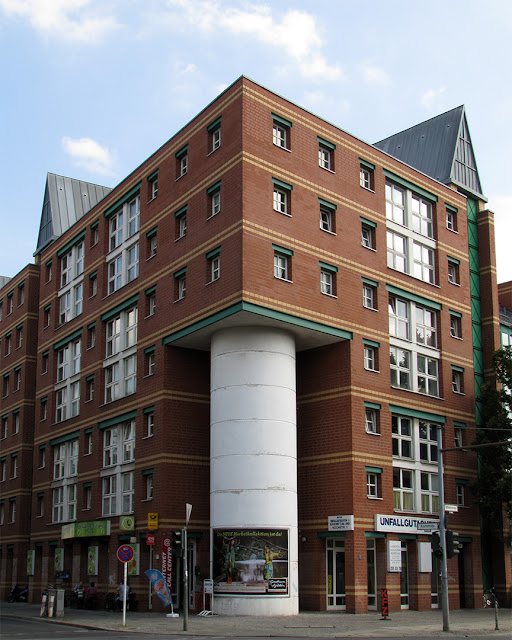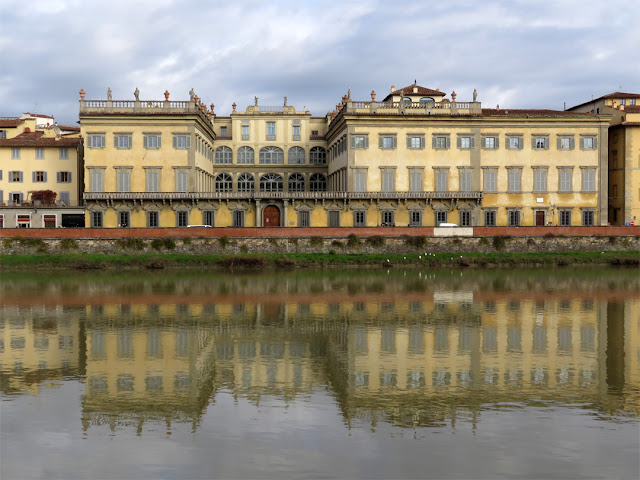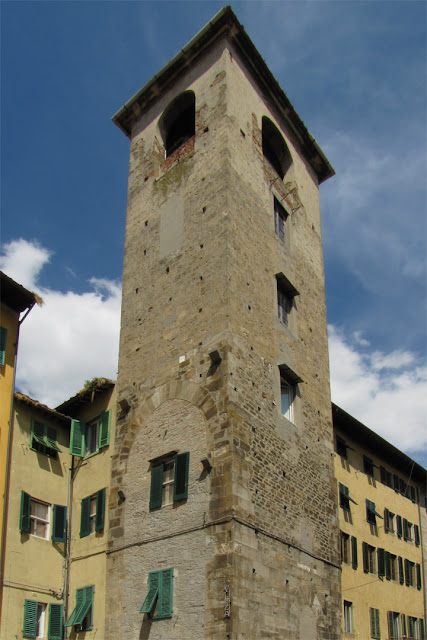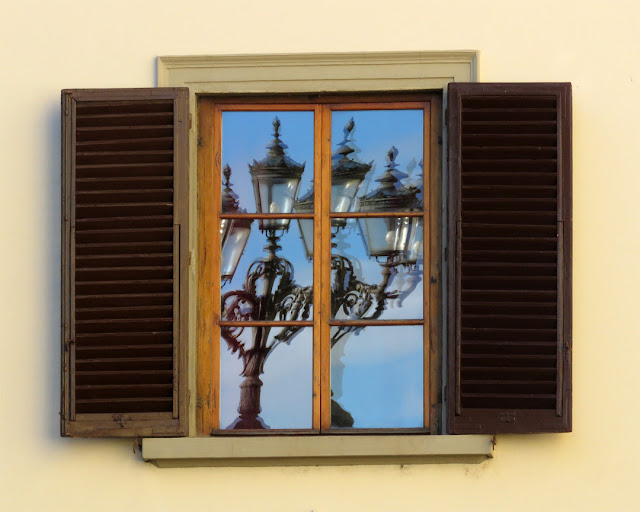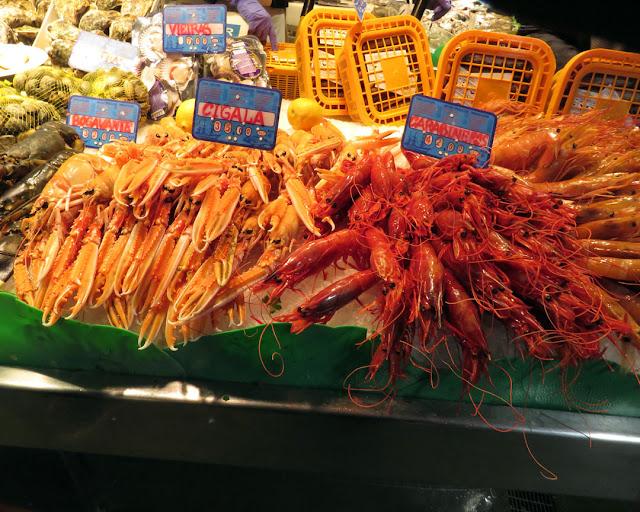Saturday, March 31, 2018
Les fruits de la terre
“Les fruits de la terre” (The Fruits of the Earth) by Georges Jeanclos, 1987
Ministère de l'Économie et des Finances
Great bronze door, Boulevard de Bercy
Quartier de Bercy, 12th arrondissement
Paris, July 2005
Friday, March 30, 2018
Orti del Parnaso
Dragon by Marco Dezzi Bardeschi, 1990
Orti del Parnaso
Giardino dell'Orticultura
Via Trento
Florence, January 2018
Thursday, March 29, 2018
Mozart-Denkmal
Mozart-Denkmal (Mozart Monument), 1896
By Karl König (architect) and Viktor Tilgner (sculptor)
Burggarten, Josefsplatz
Vienna, September 2017
“The Mozart Monument is a monument located in the Burggarten in the Innere Stadt district of Vienna, Austria since 1953. It is dedicated to composer Wolfgang Amadeus Mozart (1756–1791). This 7.5-meter-high statue was made by architect Karl König (1841–1915) and sculptor Viktor Tilgner (1844–1896) and was unveiled at Albrechtsplatz (today Albertinaplatz) on April 21, 1896, five days after Tilgner died. Tilgner's signature was completed with his death date. The sculptures are made of Laas marble from the Vinschgau, South Tyrol, whereas the steps of the foundation are made of dark diorite. The statue features componist Mozart with a music stand. The socle is adorned with ornaments, masks and wreaths and is framed within a semi-circular balustrade made of rough marble from Sterzing. The putti on the socle, which represent the power of Mozart's music, are stylistically suggestive of Art Nouveau. On the front, a relief refers to two scenes of Mozart's opera Don Giovanni. The back side relief, based on a design by Louis Carmontelle, represents the six-year-old Mozart playing music with his father Leopold and his sister Nannerl. Funds were raised for a Mozart Monument 77 years before the statue was unveiled. But choosing the design and the location of the monument was problematic. Several proposals included Rathauspark, Stadtpark and Albrechtplatz. Two art competitions were organised to select the design of the monument. Tilgner's design came second in the professional jury's choice, but was selected by the Mozart Monument Committee over Edmund von Hellmer's draft.” (Mozart Monument, Wikipedia)
Wednesday, March 28, 2018
Colonnaded Footpath
Colonnaded footpath
Parc Güell (Park Güell)
Carmel Hill
Barcelona, March 2017
“One of the three viaducts located within the park. Originally created by Antoni Gaudí to allow carriages to easily facilitate the transportation of visitors from the park's entrance to the ‘Turó de Tres Creus’ which can be found on the top of the mountain, these viaducts continue to allow guests to travel throughout the park.” (Park Güell, Wikipedia)
Tuesday, March 27, 2018
Monday, March 26, 2018
Keleti pályaudvar
Keleti pályaudvar
Eastern railway station
Kerepesi út
Budapest, September 2017
“The station stands where Rákóczi út splits to become Kerepesi Avenue and Thököly Avenue. Keleti pályaudvar translates to Eastern Railway Terminus. Its name in 1891 originates not only for its position as the easternmost of the city's rail termini, but for its original role as a terminus of the lines from eastern Hungary including Transylvania, and the Balkans. In contrast, the Nyugati (western) railway station used to serve lines toward Vienna and Paris. The building was designed in eclectic style by Gyula Rochlitz and János Feketeházy and constructed between 1881 and 1884. The main façade is adorned with two statues depicting James Watt and George Stephenson. Inside the station are frescos by Karoly Lotz.” (Wikipedia)
Sunday, March 25, 2018
Saturday, March 24, 2018
Lungarno Corsini
Palazzo Corsini
Lungarno Corsini
Florence, December 2017
“The Palazzo Corsini is a monumental palace located on Via del Parione 11, with a facade towards the Arno River, in Florence, region of Tuscany, Italy. ‘The site had been appropriated from the Ardinghelli family prior to the 17th century by the Medici, who built a casino, a small house with gardens extending to the river. In 1649, it was purchased by Maria Maddalena Macchiavelli, the wife of the Marchese Filippo Corsini, from the Grand Duke Ferdinando II de’ Medici. The palace was constructed during the mid-17th to the 18th centuries, built with one side having a U-shape wings facing the Arno to give maximum view of the river. The initial architects were Alfonso Parigi the Younger, followed by Ferdinando Tacca until 1671. Completing the massive structure was Antonio Maria Ferri.” (Palazzo Corsini, Wikipedia)
Friday, March 23, 2018
MK2 Bibliothèque
MK2 Bibliothèque by Jean-Michel Wilmotte, Véronique Kirchner and Serge Barbet, 2003
Avenue de France
Quartier de la Gare, 13th arrondissement
Paris, July 2004
Thursday, March 22, 2018
Tibidabo
Tibidabo amusement park
Plaça del Tibidabo
Collserola Ridge
Barcelona, March 2017
“Tibidabo Amusement Park (Parc d'Atraccions Tibidabo) is an amusement park located on Tibidabo in the Collserola Ridge in Barcelona. The park was built in 1899 by the entrepreneur Salvador Andreu and opened in 1905. The park is among the oldest in the world still functioning. It is Spain's longest running amusement park and Europe's third-oldest. Most of the original rides, some of which date to the turn of the 20th century, are still in use. The park is now owned by the Barcelona City Council.” (Tibidabo Amusement Park, Wikipedia)
Wednesday, March 21, 2018
Torre del Campano
Torre del Campano (Tower of the Bell)
Via Cavalca
Pisa, May 2013
“The most famous medieval building on Via Calvalca is the Torre dei Caciaioli, now known as Torre del Campano (from the bell that in the late 18th century summoned students to lectures at the university). This is a tall square building with pilasters culminating in a pointed arch in the western front, with smaller pointed arches on the other facades.” (Campano Tower and other medieval buildings, Comune di Pisa)
Tuesday, March 20, 2018
Statue of Bruncvik
Statue of Bruncvik by Ludvík Šimek, 1886
Seen from the Karlův most (Charles Bridge)
Prague, September 2017
“The sandstone statue was created by Ludvík Šimek in 1886 and donated by the city of Prague. Contrary to other statues and statuaries, the statue of Bruncvík is on the top of the bridge pillar (behind the statuary of St. Vincent Ferrer and St. Prokop) so it is easy to see from a boat on the Vltava River. It portrays a knight with a helmet, a drawn golden sword in his right hand, the emblem of the Prague Old Town on his side and his faithful lion by his feet. Below the pseudo-Gothic pedestal, there are 11 tablets with signs, the meaning of which is not clear (they are perhaps the signs of those who helped to build the bridge). The statue is a liberal restoration of fragments of the original statue of a knight from the 15th (probably made by Matěj Rejsek sometime during 1445–1506) that most likely symbolized the right of the Prague Old Town to the bridge (similar statues of Knight Roland used to also be on other old bridges and edifices, in our country e.g. on the city hall in Litoměřice and Pilsen). The statue was badly damaged by a Swedish cannon ball in 1648. Its torso and original pedestal are now in the Lapidarium of the National Museum.” (Statue of Bruncvik, Royal Route website)
Monday, March 19, 2018
Cardinal Place
Cardinal Place
Victoria Street
City of Westminster
London, January 2007
“Cardinal Place is a retail and office development in London, near Victoria Station and opposite Westminster Cathedral. The site consists of three buildings covering over a million square feet on Victoria Street next door to Portland House, and was designed by EPR Architects and built by Sir Robert McAlpine. The topping out ceremony was held in December 2004, and performed by Cardinal Cormac Murphy-O'Connor, Lord McAlpine, and Ian J. Henderson, outgoing chief executive of the site's developers Land Securities. The £200m development was built directly over the District & Circle line Underground tunnels which actually pass through the basement. The buildings rest on rubber shock absorbers to prevent vibrations from the passing trains. The project includes 550,000 square feet (51,000 m2) of office space and 100,000 square feet (9,300 m2) of retail.” (Cardinal Place, Wikipedia)
Sunday, March 18, 2018
Inside the Tepidarium
Tepidarium by Giacomo Roster, 1878
Giardino dell'Orticultura (Horticultural Garden)
Via Bolognese
Florence, January 2018
“In 1880, the Italian Horticultural Federation chose the Horticultural Garden of Florence as the venue for the First National Exhibition. For the occasion, the Tuscan Horticultural Society sponsored the construction of a large tepidarium capable of sheltering the plants from subtropical and temperate climates. This is without a doubt the garden’s most spectacular structure. Realised by the Officine Michelucci of Pistoia on a project by architect Giacomo Roster, the work constituted an extraordinary example of architecture in iron and glass that was emerging on the national panorama. The daring building with its metal structure supported by 24 cast-iron columns is situated more or less on the spot where the ‘Chinese Pavilion’ had stood only a few years before. The tepidarium stimulated the interest for botanical research and experimentation in greenhouse cultivating.” (Horticultural Garden, Scientific Itineraries in Tuscany)
Saturday, March 17, 2018
Girl with a Deer
Girl with a Deer by Alojz Rigele
Hviezdoslavovo námestie
Staré Mesto
Bratislava, September 2017
“Walking further through the Hviezdoslav’s Square, admire this romantic fountain which is an illustration to a German folk fairy-tale from Grimm brothers about a sister and a brother. In the story, the brother turns into a deer when drinking from a well. It was created by a sculptor Alojz Rigele originally for a park in Petržalka. However, when finalized after Rigele’s death, it was no more possible to place it to Petržalka since it was occupied by Hitler’s Germany at that time. Luckily, a perfect location was found at the Hviezdoslav’s Square. Sometimes this fountain is also called Diane and some claim it depicts the Goddess of Hunt Diane with a tame deer. Either way, we love its simple but magical design!” (Bratislava Fountains, Welcome to Bratislava)
Friday, March 16, 2018
Église du Saint-Esprit
Église du Saint-Esprit, by Paul Tournon, 1935
Avenue Daumesnil
Quartier de Picpus, 12th arrondissement
Paris, July 2014
“The Église Saint-Esprit was built between 1928 and 1935 by the architect Paul Tournon following a plan inspired by that of the Hagia Sophia in Istanbul. It was built of reinforced concrete with a facing of red bricks from Burgundy. Tournon said that the huge dome made light by the row of openings at its base, with the square nave that supported it, symbolized the union of the divine and the earth. The dome is 22 metres (72 ft) in diameter and its summit is 33 metres (108 ft) above ground level. Use of reinforced concrete for the vertical supports and the dome was a major technical feat at the time.” (Wikipedia)
Thursday, March 15, 2018
Ferdinando I de' Medici
Statue of Ferdinando I de' Medici by Pietro Francavilla, 1595
Piazza Francesco Carrara
Pisa, May 2013
Wednesday, March 14, 2018
Franz von Assisi
Kirche zum heiligen Franz von Assisi (St. Francis of Assisi Church), 1913
Mexikoplatz, Leopoldstadt
Vienna, September 2017
“St. Francis of Assisi Church (Kirche zum heiligen Franz von Assisi), also known as the Emperor's Jubilee Church (Kaiserjubiläumskirche) and the Mexico Church (Mexikokirche), is a Basilica-style Catholic church in Vienna, Austria. Built between 1898 and 1910, it was consecrated in 1913.[1] It is located on the Mexikoplatz in Vienna's Second District, Leopoldstadt, and is administered by the Order of the Holy Trinity.The construction of the church celebrated the 50th anniversary of the reign of Emperor Franz Joseph I of Austria. A competition was held to select the design and was won by architect Victor Luntz. The four-bay, basilica-like brick building was intended as a garrison church; designed in the Rhenish-Romanesque style, its three red-tiled towers are visible several kilometres away. The church, which is directly situated near the Danube, is now home to the Vienna English Speaking Catholic Community (VESCC) who have held weekly masses at the church since moving there in 2009. The Mexikoplatz (Mexico Square), formerly known as Erzherzog-Karl-Platz (Archduke-Karl-Square), commemorates the fact that Mexico was the only country outside the Soviet Union to protest against the Anschluss of Austria to Nazi Germany." (St. Francis of Assisi Church, Vienna, Wikipedia)
Tuesday, March 13, 2018
Detlev-Rohwedder-Haus
Detail of the mural by Max Lingner, 1952
Detlev-Rohwedder-Haus (Detlev Rohwedder House)
Leipziger Straße
Berlin, September 2011
“Between 1950 and 1952 an extraordinary 18 metres (59 ft) long mural, made out of Meissen porcelain tiles, was created at the north end along Leipziger Straße, set back behind pillars. Created by the German painter and commercial artist Max Lingner together with 14 artisans, it depicts the Socialist ideal of contented East Germans facing a bright future as one big happy family. In fact the mural's creation was a somewhat messy affair. Commissioned by the Prime Minister, Otto Grotewohl, Lingner had had to revise it no fewer than five times, so that it ultimately bore little resemblance to the first draft. Originally based on family scenes, the final version had a more sinister look about it, a series of jovial set-pieces with an almost military undertone, people in marching poise and with fixed, uniform smiles on their faces. Lingner hated it (as well as Grotewohl's interference) and refused to look at it when going past. With a degree of irony, the building became the focal point a year later of the Uprising of 1953 in East Germany.” (Detlev-Rohwedder-Haus, Wikipedia)
Monday, March 12, 2018
Reflected Lamp Post
Lamp post reflected in a window
Piazza de' Pitti
Florence, January 2018
“The square was conceived in 1440, when the bankier Luca Pitti decided to build a very big palace in order to show to the whole city how rich and powerful his family was. The ambitious project included a square in front of the palace: for its building Luca Pitti bought and demolished all the houses flanking a part of the street Borgo di Piazza (today: Via Guicciardini). This open place was soon called «Via del Palagio dei Pitti» (Street of the Pitti's palace), but the building of the palace and of the whole square remained uncompleted due to its frightening cost - even for the so rich Luca Pitti such an adventure proved soon to be too expensive. In 1549 Elonora di Toledo, wife of Cosimo I de' Medici, bought the palace, which was then enlarged and widened in several times; in 18th Century a part of the square was filled by the two side-wings of the palace, built after a design of Giuseppe Ruggeri and Pasquale Poccianti, and a portion of the ancient Palazzo Guicciardini was demolished, in order to give to the square a more regular shape.” (Pitti Square, Firenze-Oltrarno.net)
Sunday, March 11, 2018
Néprajzi Múzeum
Néprajzi Múzeum (Ethnographic Museum)
Kossuth Lajos tér
Budapest, September 2017
“The Ethnographic Museum (Hungarian: Néprajzi Múzeum) is a national museum in Budapest, Hungary. It was founded as the Ethnographic Department of the Hungarian National Museum in 1872. Its first director was John Xantus de Vesey. It formally split from the National Museum in 1947 but moved to its building in Kossuth Square, opposite the Parliament building, only in 1973. The grand building in which the Museum of Ethnography is now housed was originally built by Alajos Hauszmann for the Ministry of Justice. The museum houses a collection of Hungarian folk objects from the 19th century. The collection includes pieces from everyday Hungarian life from before World War II, including pottery, costumes, boats, and furniture. Many of the objects are from Upper Hungary and Transylvania. Also featured in the museum are scenes from everyday Hungarian life around 1900. These include a model of a kitchen and a model of a church.” (Ethnographic Museum, Wikipedia)
Saturday, March 10, 2018
Palau Nacional
Museu Nacional d'Art de Catalunya
Palau Nacional (National Palace)
Parc de Montjuïc
Barcelona, March 2017
“The Museu Nacional d'Art de Catalunya (National Art Museum of Catalonia), abbreviated as MNAC, is the national museum of Catalan visual art located in Barcelona, Catalonia, Spain. Situated on Montjuïc hill at the end of Avinguda de la Reina Maria Cristina, near Pl Espanya, the museum is especially notable for its outstanding collection of romanesque church paintings, and for Catalan art and design from the late 19th and early 20th centuries, including modernisme and noucentisme. The museum is housed in the Palau Nacional, a huge, Italian-style building dating to 1929. The Palau Nacional, which has housed the Museu d'Art de Catalunya since 1934, was declared a national museum in 1990 under the Museums Law passed by the Catalan Government. That same year, a thorough renovation process was launched to refurbish the site, based on plans drawn up by the architects Gae Aulenti and Enric Steegmann, who were later joined in the undertaking by Josep Benedito. The Oval Hall was reopened in 1992 on the occasion of the Olympic Games, and the various collections were installed and opened over the period from 1995 (when the Romanesque Art section was reopened) to 2004. The Museu Nacional d'Art de Catalunya (Museu Nacional) was officially inaugurated on 16 December 2004. It is one of the largest museums in Spain.” (Museu Nacional d'Art de Catalunya, Wikipedia)
Friday, March 9, 2018
Thursday, March 8, 2018
Mairie du 11e
Detail of the façade by Antoine-François Gancel, 1865
Mairie (town hall) of the 11th arrondissement
Place Léon-Blum
Quartier de la Roquette, 11th arrondissement
Paris, July 2012
Wednesday, March 7, 2018
Tuesday, March 6, 2018
External Staircase
External staircase
Biblioteca delle Oblate (Oblate Library)
Via dell'Oriuolo
Florence, January 2018
“Opened in May 2007, the Oblate Library is a small treasure in the heart of Florence. Located in the former Convent of the Oblate between Via dell'Oriuolo and Via Sant'Egidio, it is a cultural and multimedia center that fuses the antique and modern soul of the city. The Municipality of Florence took inspiration from the famous Georges Pompidou Center in Paris, both for the contemporary furnishing and modern services for visitors that the library offers.” (The Oblate Library, Visit Florence)
Monday, March 5, 2018
Obecní dům
Obecní dům (Municipal House)
Náměstí Republiky
Staré Město (Old Town)
Prague, September 2017
“Municipal House (Czech: Obecní dům) is a civic building that houses Smetana Hall, a celebrated concert venue, in Prague. It is located on Náměstí Republiky next to the Powder Gate in the center of the city. The building is of the Art Nouveau architecture style. The building exterior has allegorical art and stucco. There is a mosaic called Homage to Prague by Karel Špillar over the entrance. On either side are allegorical sculpture groups representing ‘The Degradation of the People’ and ‘The Resurrection of the People’ by Ladislav Šaloun. Smetana Hall serves as a concert hall and ballroom. It has a glass dome. It houses artwork by Alfons Mucha, Jan Preisler and Max Švabinský.” (Municipal House, Wikipedia)
Sunday, March 4, 2018
La Boqueria
Mercat de Sant Josep de la Boqueria
La Rambla
Barcelona, March 2017
“The Mercat de Sant Josep de la Boqueria, often simply referred to as La Boqueria, is a large public market in the Ciudad Vieja district of Barcelona, Catalonia, Spain, and one of the city's foremost tourist landmarks, with an entrance from La Rambla, not far from the Liceo, Barcelona's opera house. The market has a very diverse selection of goods.” (La Boqueria, Wikipedia)
Saturday, March 3, 2018
Friday, March 2, 2018
Gamča
Gamča by Ödön Lechner, 1908
Gymnázium, Grösslingova
Bratislava, September 2017
“The current building was designed by Ödön Lechner and built in 1906-08. Few years later its ‘chapel’, today known as Church of St. Elisabeth (Bratislava), was added. The school building was completely renovated in 2008-10.” (Gamča, Wikipedia)
Thursday, March 1, 2018
Wir sind die Niedersachsen
“Wir sind die Niedersachsen” (We are the Lower Saxony)
Vertretung des Landes Niedersachsen beim Bund
Ministergärten
Berlin, September 2011
“The elephant sculpture was conceived in the regional capital of Hannover. Malicious tongues say it is no coincidence that the name of the rivaling city of Braunschweig has been placed in an unfortunate spot. This red elephant can be found in front of the Representation of Lower Saxony at the Federal Government in Berlin. While there is no direct connection between the Northern German federal state and the Indian mammal, an elephant certainly is more capable of accomodating all the names of Lower Saxon towns and municipalities than the actual heraldic animal – a horse.” (Wir sind die Niedersachsen, Fonts in Use)
Subscribe to:
Posts (Atom)







